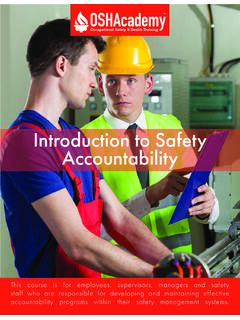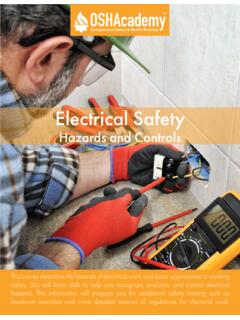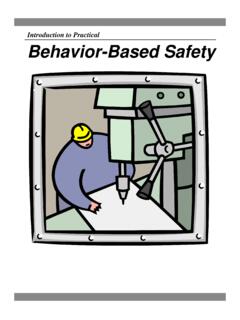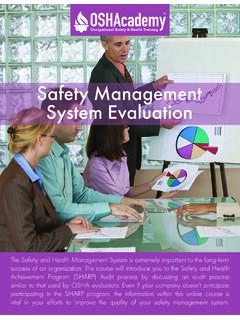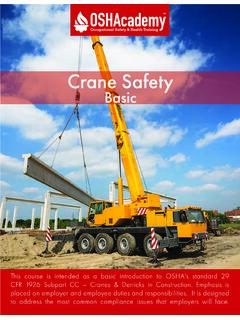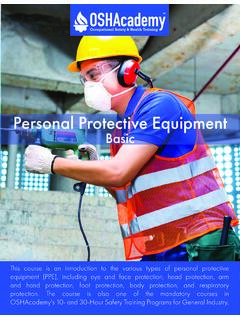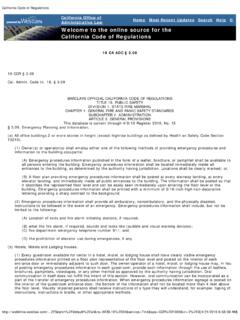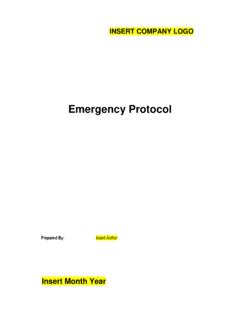Transcription of Emergency Action Plans and Fire Prevention Plans
1 Emergency Action Plans and fire Prevention Plans This course is an introduction to the elements of an effective Emergency Action plan and fire Prevention plan . Employers are required to have these two safety Plans to help ensure they are prepared in Emergency situations. This page intentionally blank OSHA cademy Course 107 Study Guide Emergency Action and fire Prevention Plans Copyright 2018 Geigle Safety Group, Inc. No portion of this text may be reprinted for other than personal use. Any commercial use of this document is strictly forbidden. Contact OSHA cademy to arrange for use as a training document. This study guide is designed to be reviewed off-line as a tool for preparation to successfully complete OSHA cademy Course 107. Read each module, answer the quiz questions, and submit the quiz questions online through the course webpage. You can print the post-quiz response screen which will contain the correct answers to the questions.
2 The final exam will consist of questions developed from the course content and module quizzes. We hope you enjoy the course and if you have any questions, feel free to email or call: OSHA cademy 15220 NW Greenbrier Parkway, Suite 230 Beaverton, Oregon 97006 +1 (888) 668-9079 Disclaimer This document does not constitute legal advice. Consult with your own company counsel for advice on compliance with all applicable state and federal regulations. Neither Geigle Safety Group, Inc., nor any of its employees, subcontractors, consultants, committees, or other assignees make any warranty or representation, either express or implied, with respect to the accuracy, completeness, or usefulness of the information contained herein, or assume any liability or responsibility for any use, or the results of such use, of any information or process disclosed in this publication. GEIGLE SAFETY GROUP, INC., DISCLAIMS ALL OTHER WARRANTIES EXPRESS OR IMPLIED INCLUDING, WITHOUT LIMITATION, ANY WARRANTIES OF MERCHANTABILITY OR FITNESS FOR A PARTICULAR PURPOSE.
3 Taking actions suggested in this document does not guarantee that an employer, employee, operator or contractor will be in compliance with applicable regulations. Ultimately every company is responsible for determining the applicability of the information in this document to its own operations. Each employer s safety management system will be different. Mapping safety and environmental management policies, procedures, or operations using this document does not guarantee compliance regulatory requirements. This page intentionally blank Course 107 Copyright 2018 Geigle Safety Group, Inc. Page 1 of 24 Contents Course Introduction .. 3 Modules and Learning Objectives .. 4 Module 1: Emergency Action plan (EAP) .. 6 Introduction .. 6 Elements of the EAP .. 7 Reporting Emergencies .. 8 Evacuation Procedures .. 8 Exit Routes .. 10 Assisting Others to Evacuate .. 11 Employees Who May Remain to Shut Down .. 12 Accounting for Employees.
4 13 fire , Rescue, and Medical Services .. 14 Module 2: fire Prevention Plans (FPP) .. 15 Introduction .. 15 FPP Responsibilities .. 16 Written plan Components .. 17 FPP Best Practices .. 18 Hazards that Cause Fires .. 19 fire Extinguishing Systems .. 20 How to Use a fire Extinguisher .. 21 FPP Training Requirements .. 22 Additional Resources .. 24 Course 107 Copyright 2018 Geigle Safety Group, Inc. Page 2 of 24 This page intentionally blank Course 107 Copyright 2018 Geigle Safety Group, Inc. Page 3 of 24 Course Introduction Several Occupational Safety and Health Administration (OSHA) standards explicitly require employers to have Emergency Action Plans (EAPs) for their workplaces. Emergency preparedness is a well-known concept in protecting workers' safety and health. To help employers, safety and health professionals, training directors, and others, the OSHA requirements for emergencies are compiled and summarized in this course.
5 fire safety becomes everyone's job at a worksite. Employers must develop fire Prevention Plans (FPPs) and train workers about fire hazards in the workplace and what to do in a fire Emergency . If you want your workers to evacuate, you should train them on how to escape. If you expect your workers to use firefighting equipment, you must give them appropriate equipment and train them to use the equipment safely. The EAP and FPP, along with Preventing Workplace Violence , should all be combined into an overall Emergency Preparedness Program to protect employees and help ensure continuity of the organization's business services. This short course provides an overview of OSHA standards for emergencies contained within OSHA , Emergency Action Plans , and , fire Prevention Plans . It is not intended to alter or determine compliance responsibilities in OSHA standards or the Occupational Safety and Health Act of 1970. Please review the current OSHA standards applicable to your work operations to ensure your compliance.
6 Course 107 Copyright 2018 Geigle Safety Group, Inc. Page 4 of 24 Modules and Learning Objectives Module 1: Emergency Action plan (EAP) Learning objectives in this module include: List key elements in the Emergency Action plan (EAP). Discuss reporting requirements under the EAP. Describe a typical evacuation procedure if a fire occurs. Discuss important requirements for exit routes. Describe evacuation warden requirements and duties. Discuss requirements for employees who do not evacuate. Discuss requirements for accounting for employees and assembly areas. Identify important points when coordinating with fire , rescue, and medical services. Module 2: fire Prevention plan (FPP) Learning objectives in this module include: Describe responsibilities for fire Prevention plan (FPP) managers and administrators. Discuss FPP responsibilities for supervisors and employees. Describe the requirement for a written FPP and identify components.
7 Identify at least five best practices under the FPP. List and give examples of the various fire hazards in the workplace. Identify and describe the two primary types of fire extinguishing systems. Describe the PASS method for using fire extinguishers. Course 107 Copyright 2018 Geigle Safety Group, Inc. Page 5 of 24 Describe FPP education and training requirements for managers, supervisors, and employees. Course 107 Copyright 2018 Geigle Safety Group, Inc. Page 6 of 24 Module 1: Emergency Action plan (EAP) Introduction How would you escape from your workplace in an Emergency ? Do you know where all the exits are in case your first choice is too crowded? Are you sure the doors will be unlocked and the exit route, such as a hallway, will not be blocked during a fire , explosion, or other crisis? Knowing the answers to these questions could keep you safe during an Emergency . An Emergency Action plan (EAP) is a written document required by OSHA Standard The purpose of an EAP is to facilitate and organize employer and employee actions during workplace emergencies.
8 Well-developed Emergency Plans and proper employee training (such that employees understand their roles and responsibilities within the plan ) will result in fewer and less severe employee injuries and less structural damage to the facility during emergencies. A poorly prepared plan , likely will lead to a disorganized evacuation or Emergency response, resulting in confusion, injury, and property damage. Emergency Action Plans must be written. However, for smaller companies, the plan does not need to be written and may be communicated orally if there are 10 or fewer employees. Quiz Instructions After each section, there is a quiz question. Make sure to read the material in each section to discover the correct answer to these questions. Circle the correct answer. When you are finished go online to take the final exam. This exam is open book, so you can use this study guide. 1. The Emergency Action plan (EAP) may be written or communicated orally if there are fewer than _____ employees.
9 A. 5 b. 10 c. 15 d. 20 Course 107 Copyright 2018 Geigle Safety Group, Inc. Page 7 of 24 Elements of the EAP At a minimum, the plan must include but is not limited to the following elements: Means of reporting fires and other emergencies, Evacuation procedures and Emergency escape route assignments, Procedures for employees who remain to operate critical plant operations before they evacuate, Accounting for all employees after an Emergency evacuation has been completed, Rescue and medical duties for employees performing them, and Names or job titles of persons who can be contacted. Although they are not specifically required by OSHA, employers may find it helpful to include the following in the EAP: A description of the alarm system to be used to notify employees (including disabled employees) to evacuate and/or take other actions. The alarms used for different actions should be distinctive and might include horn blasts, sirens, or even public-address systems.
10 The site of an alternative communications center to be used in the event of a fire or explosion. A secure on- or offsite location to store originals or duplicate copies of accounting records, legal documents, your employees' Emergency contact lists, and other essential records. 2. Which of the following is a MANDATORY element in the Emergency Action plan (EAP)? a. Alternate communications center b. Description of alarm systems c. Means of reporting fires d. Secure offsite storage areas Course 107 Copyright 2018 Geigle Safety Group, Inc. Page 8 of 24 Reporting Emergencies Employees must know how to report emergencies. Some use internal telephone numbers, intercom, or public-address systems to notify other employees. It is important for employees to also notify the proper authorities such as fire , medical, or rescue services, if your company relies on this type of assistance during an Emergency . There are preferred procedures for reporting emergencies such as dialing 911, or an internal Emergency number, or pulling a manual fire alarm but there are many other possibilities.
